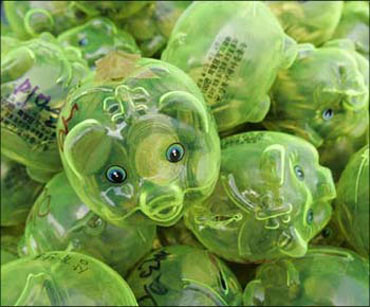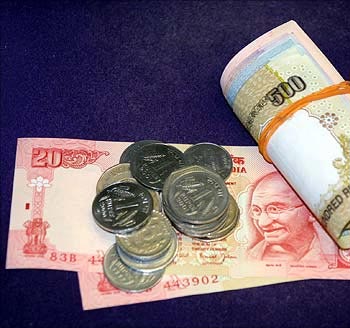Shonalee Biswas
The Reserve Bank of India raised the interest paid on savings bank account to 4 per cent from the current 3.5 per cent.
What this means in simple English is that if you put Rs 100 in a savings bank account and hold it for one year you will get Rs 104 at the end of the year. Earlier you would have got Rs 103.50.
While this is a step in the right direction, the RBI could have gone a step further and freed the interest rate on savings account completely.
Such a move would have allowed different banks to pay different rates of interest on their savings accounts, like is the case with fixed deposits currently.
In the current environment where interest rates are headed upwards, this would have meant a higher rate of interest on the savings account deposits from the current rate of 4 per cent and this would have benefited the depositors.
. . .
Why RBI should have freed the savings rate
Let us see why such a move would have made immense sense.
Inflation at 9%
The wholesale price index (WPI), which is a measure inflation (the rate at which prices are rising) in the country, was at 9 per cent for the month of March 2011.
This means that prices in March 2011 where 9 per cent higher than prices in March 2010.
Of course, prices at the consumer level are even higher. Given this, when the rate of inflation is at 9 per cent, why should the savings account pay an interest of only 4 per cent?
One explanation is that a savings account allows the depositor to withdraw money from the account at any point in time.
. . .
Why RBI should have freed the savings rate
With this flexibility that the bank allows the depositor, comes the low rate of interest.
While this is a fair argument but the difference of 5 per cent (9%-4%) between the rate of inflation and the savings rate is way too large.
Easy money for banks
Deposits in savings account form nearly 22 per cent of total deposits with scheduled commercial banks.
On this they will now have to pay an interest of 4 per cent against 3.5 per cent earlier. This is easy money for the bank.
In comparison banks are now paying anywhere between 8-10 per cent (even higher in some cases for senior citizens) on fixed deposits, which is the other primary mode of funding for a bank.
. . .
Why RBI should have freed the savings rate
In an environment where interest rates are likely to keep going up, banks wouldn't want a complete deregulation of the interest to be paid on a savings account.
A complete deregulation would lead to a situation where banks which have lower savings account deposits would have to offer a higher rate of interest than the current 4 per cent.
Such a move would lead to money flowing from banks which have a higher savings account deposits to those which have lower savings account deposits.
In turn the bank with higher savings account deposits would also have to offer a higher interest. This would also increase the cost of borrowing for banks.
The RBI data
Given this possibility, most public sector banks which are high on savings account deposits because of their larger penetration, would be against such a move.
. . .
Why RBI should have freed the savings rate
In fact, a discussion paper put out by the Reserve Bank of India sometime back makes a very interesting point.
The paper says that banks which have current and savings account deposits of greater than 50 per cent of total deposits have a cost of funds of 2.2 per cent. This goes up to 5.4 per cent for banks which have current and savings account deposits between 30 per cent and 40 per cent.
The cost of funds is the average cost of borrowing for a bank.
In the current environment if the rate of interest on savings accounts is freed, it is likely to go up. This would mean that the cost of borrowing for banks would go up.
Cost of borrowing going up would mean lower profits if banks are not able to pass on this increase to their customers through higher rates of interest on loans.
. . .
Why RBI should have freed the savings rate
And that is the primary reason why RBI has raised the interest rate to 4 per cent and not freed it completely.
Newspaper reports suggest that some public sector banks opposed any such move.
Interestingly enough, before March 1, 2003, the savings account interest was at 5.5 per cent. Back then, interest rates were falling and most of the banks wanted RBI to totally deregulate the interest rate on the savings account and let the market decide the rate of interest a particular bank offers on its savings account.
Of course, that did not happen, and RBI simply brought down the rate to 3.5 per cent.
A chance of lower interest
Of course, if the rate if freed, chances are that in the days to come savings account would even offer a rate of interest lower than 4 per cent. This would be when banks are flush with funds and lending is slow.
But in such an environment inflation would also be low. So the freeing of the interest rate would lead to a situation where depositors are paid an interest according to the inflation prevailing at that point of time.
The author can be reached at shonalee.biswas@gmail.com







article